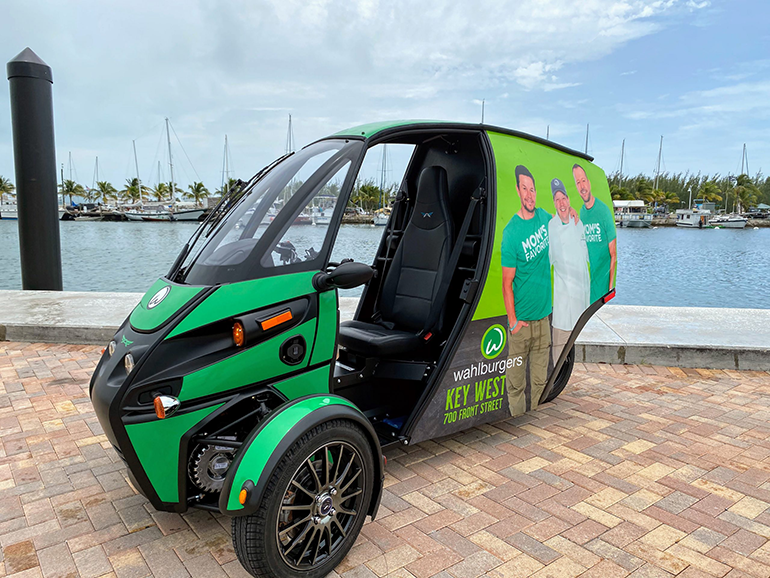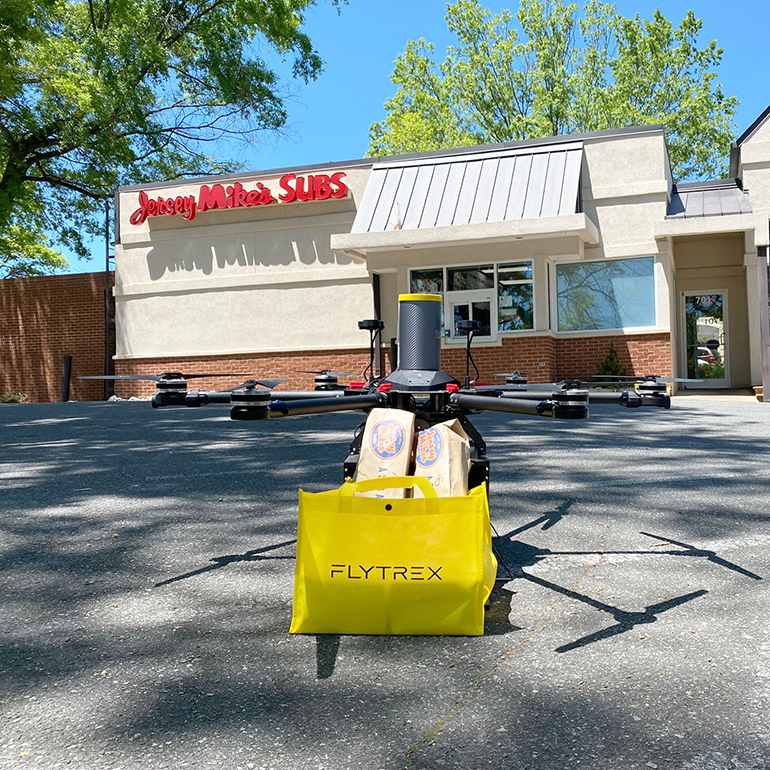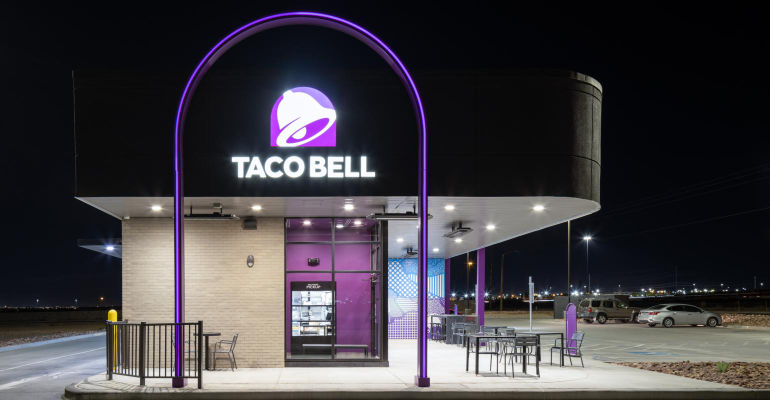The pizza and Asian categories got us familiar with food delivery decades ago. The pandemic brought every other category up to speed, and now consumers have access to restaurant meals at their fingertips without having to leave the comfort of their own couch.
Of course, the steep (and continuing) rise in delivery isn’t news in late 2023. What is worth exploring now is how brands are evolving and innovating to protect and enhance this now-critical revenue stream. Those efforts include finding the sweet spot for promotional activity, investing in the right packaging and equipment, translating in-restaurant experiences, deploying the right technology, and redesigning restaurants to ensure off-premises efficiencies. To put a finer point on it, the off-premises consumer is now top of mind and that shift has impacted restaurant innovations — and it will continue to do so.
“The largest operators are using electric vehicles, voice ordering, and heated delivery bags — all to provide a more convenient and sustainable service to their guests. Most guests, though, want to order from their local restaurant at a reasonable price. Speed isn’t everything — focus on providing a reliable service that delivers the great food and leverages the brand you’ve already built,” said Scott Landers, cofounder and CEO of off-premises consulting company Figure 8. “Guest preferences continue to shift toward convenience. Offering efficient and convenient delivery services is essential for staying relevant.”

Restaurant redesigns
As restaurants contemplate how to achieve that relevancy in the delivery space, more are rethinking their restaurant designs and kitchen layouts all together. In the past three years alone, off-premises-focused models — many of which don’t even have a dining room — have been introduced by White Castle, Jimmy John’s, Wingstop, Jack in the Box, KFC, Taco Bell, Arby’s, Wendy’s, Burger King, Whataburger, Del Taco and McDonald’s, among others.
McDonald’s CEO Chris Kempczinski recently told analysts that “a big reason we can look at those (formats) is because of the growth that’s happened with digital and delivery where you don’t necessarily need the big dining rooms that you need in our traditional restaurants.”
Freddy’s Frozen Custard & Steakburgers, which generates nearly 70% of its business off-premises, has reimagined its restaurant designs to incorporate features that optimize the delivery channel. Its new prototype in Belleville, Ill., features a dedicated mobile pickup station, complete with a custard freezer, ensuring that third-party delivery services can handle orders seamlessly without sacrificing product quality, said CEO and president Chris Dull. Changes have also been made in the kitchen to streamline off-premises business.
“We’ve implemented innovative technology, such as Accutemp’s XLR8, to increase efficiency for our team members and ensure product consistency,” Dull said. “Other updates that positively impact delivery include the revamping of our bagging station and the creation of a shared expo counter. This enables the restaurant team to manage all aspects of delivery orders with accuracy and speed.”
Smoothie King, one of the top three QSR brands according to Technomic’s data measuring delivery satisfaction scores, also recently introduced a new store prototype that includes a dedicated drive-thru lane specifically for online and delivery orders.
“We’re seeing a lot of success. It’s a win/win for team members, delivery partners, and our guests,” said CMO Marianne Radley. The prototype, combined with new technology, including an easier app, and optimized logistic solutions, has increased accessibility to the brand.
“They have been critical components of our evolved digital strategy focused on acquiring new guests and increasing the frequency of existing guests,” Radley said.
Even casual-dining chains are getting into the restaurant redesign game to meet increased off-premises demand. Applebee’s franchisee Doherty Enterprises just opened a To Go version of the brand’s traditional concept in part to maximize delivery speed by including pickup lockers. Those lockers (or cubbies or shelves) are a big part of this shift toward an industry-wide off-premises redesign trend, as are dedicated pickup lanes at the drive-thru or parking spots for delivery drivers. Taco Bell’s Go Mobile design includes all these elements and was created, in part, to optimize delivery times.
“Our delivery drivers we view as a key stakeholder. How do they have an easier experience? If it’s easier for them to access our brand, that translates to more sales,” said Scott Mezvinsky, managing director of Taco Bell North America. “We’re going after the same challenges, we’re just thinking about how to do it tighter as the digital business grows so fast, and so our technology and designs accommodate where the customer is today.”
Wahlburgers started testing electric vehicles from Arcimoto in 2020.
The technology supporting delivery
Technology has obviously facilitated this rise in delivery and therefore plays a critical role in its success, whether through consumer-facing features or back-of-house systems. Consider Yum Brands as a good example of the latter. In 2021, the company acquired Dragontail Systems to sequence the timing of each order, plan optimal delivery routes and combine delivery orders by location. The system is now deployed in over 1,000 KFC and Pizza Hut locations and, according to CEO David Gibbs, has led to higher customer satisfaction scores and better product quality.
On the consumer-facing side, there perhaps is no better example than Domino’s, which launched its Pizza Tracker feature in 2008 — a lifetime ago in tech terms. It never rested on its laurels, since launching GPS tracking for delivery in 2019, Apple Car Play, Hotspots and much more. Most recently, Domino’s introduced Pinpoint delivery, which allows customers to drop a pin in the app and get their order delivered to them wherever they are. During Domino’s most recent earnings call, CEO Russell Weiner said Pinpoint is one of 20 different ways customers can order pizza, illustrating the continued evolution in the space.
“We are obsessed with delivery … and we do it because we think there’s a competitive advantage to owning the entire customer experience,” he said.
Vehicle evolution
Delivery-focused technology has even trickled into the delivery vehicles themselves. For its part, Domino’s has been testing self-driving delivery vehicles for several years now, including through a partnership with Nuro launched in 2021. Chipotle also invested in Nuro that year to leverage its autonomous vehicles.
Further, there is an uptick in electric vehicle adoption to reduce carbon emissions as delivery grows. Domino’s is yet again an example here, recently committing to more than 1,100 Chevy Bolt Electric Vehicles by the end of the year. Chick-fil-A’s new Little Blue Menu location in College Park, Md., features hybrid electric vehicles, while Wahlburgers started testing Arcimoto’s electric vehicles in 2020.
And then there’s drone delivery. The technology is still on the ground floor, so to speak, but several brands are piloting its potential, including Freddy’s, Little Caesars and Papa Johns — all of which recently partnered with Flytrex to use its fully autonomous delivery process. That process enables drones to pick up orders from restaurants using a dropdown wire, then fly to a customer’s home for drop off.
Flytrex drones are used by Jersey Mike’s, plus Freddy’s, Little Caesars, and Papa Johns.
“It’s an interesting glimpse into future innovations while aligning with our commitment to delivering an elevated experience to our guests,” Freddy’s Dull said. “Flytrex drone technology presents us with a unique opportunity to achieve quicker delivery times. As we test the technology, we will carefully observe how it streamlines the delivery process and ensures faster and fresher food deliveries to our guests.”
Yariv Bash, CEO and cofounder of Flytrex, said drones allow foodservice customers to receive orders “fresher, faster, and for a fraction of the price compared to traditional on-demand services.”
“Our numbers are the best proof; over the last six months, our marketplace (gross order value) sales grew by nearly 200%, and active users almost tripled,” Bash said.
Notably, Sweetgreen is also testing drone delivery with Zipline, while Nekter Juice Bar, Mad Greens and Tokyo Joe’s are piloting drone delivery with Flyby.
Replicating the in-store experience
Beyond the shiny tech deployments, there are also several innovations worth mentioning about brands trying to replicate their on-premises experience to off-premises guests. Take Carvel — another top three QSR delivery brand based on Technomic’s data (which may come as a bit of a surprise for anyone who’s tried to transport ice cream from, say, the grocery store to home). The company has found a way to translate its experience by holding its products in freezers at -10 to -20 degrees before they’re picked up by a delivery driver, according to chief brand officer Jim Salerno.
“The pandemic changed consumer behavior and the overall delivery landscape and it’s important to us that we are meeting customers where they are with the products they love,” Salerno said. “We work hard to ensure guests have a great experience no matter where or how they pick up our products.”
Pepper Lunch is also exploring a way to translate its unique sizzling hot plate experience to off-premises customers. CEO Troy Hooper said the company is testing a “unique technology called a rotating kennel wok” to do just that.
“It will allow Pepper Lunch to expand and better promote our off-premises business in a way we don’t do today due to the challenges of delivering that same service model,” Hooper said. “We are a brand that for 30 years has not focused on off-premises, but the consumer now wants it and deserves it and is only going to want it more and more as time goes on, and so we need to develop a plan just like everyone else.”
Promotional activity
Promotional adjustments are the low-hanging fruit when it comes to staying relevant, and operators are now basing such promotions on labor availability and volume during certain dayparts. Checkers and Rally’s, for instance, is intentionally promoting its delivery channel at night. CEO Frances Allen said 50% of the company’s late-night business is delivery, while the channel makes up about 18% overall.
“Our delivery channel is still growing 1-2% a year and is especially strong at night, which has helped that daypart’s recovery,” she said. “We excel in late-night, and that is in large part due to delivery, and so that’s where we’re really focused.”
Other brands are simply focused on leveraging third-party platforms because they generate a lot of eyeballs (Uber Eats was estimated to have about 81 million users across the world last year). As such, long-time holdouts like Domino’s and Jimmy John’s have begun leveraging third-party delivery services. For Red Robin, the third-party opportunity has inspired the company to invest more in those aggregators.
“Candidly, we didn’t do as good of a job as we could have and so we’re now resetting those relationships,” said CEO GJ Hart. “If we show up on page four, we’re not going to be a top choice for customers looking for a burger. We think investing more will allow us to do more. Delivery is here to stay, so we have to make sure we do it well.”
As more companies look to find their sweet spot with third-party delivery, a growing number are striking a balance with their own fleets. Papa Johns, for instance, held onto its own drivers while leveraging third-party drivers during peak hours.
“The delivery experience is really an extension of the buying journey for customers,” Papa Johns CEO Rob Lynch said during the recent Prosper Forum. “More and more brands are trying to control it.”
Landers said the best delivery is self-delivery, as it allows brands to better maintain reputational control and facilitate a more palatable fee structure. Also, most consumers trust first-party delivery versus third-party platforms. For companies that don’t have their own drivers, it’s wise to partner with a local logistics service, he said.
They’re also trying to maximize delivery
More brands are also trying to maximize delivery to make up for the additional resources and focus it requires. As such, several restaurants have hung onto the virtual brands they launched during the throes of the pandemic to make up for lost dine-in sales. A good example here is Dog Haus, which continues to grow its delivery-only Bad-Ass Breakfast Burritos brand. Bad-Ass delivers a significant uptick in revenue between 1 a.m. and 6 a.m., when the Dog Haus kitchens are otherwise underutilized.
IHOP has also found that its growing virtual portfolio has beefed up the company’s late-night business when the kitchen is otherwise slow.
“We believe virtual brands are part of what’s propelling that business. They enable us to expand our reach and allow us to be top-of-mind for more customers,” said John Peyton, CEO of IHOP parent Dine Brands.
Tip of the iceberg
All of these examples are just the tip of the iceberg when it comes to the industry’s shift to meet the expectations of an omnichannel customer. We haven’t even scratched the surface of packaging upgrades made to retain heat during delivery time, like Shake Shack is testing this year. Nor have we touched on equipment upgrades meant to do the same, such as the case with Red Robin’s new flattop grills.
Contact Alicia Kelso at [email protected]

